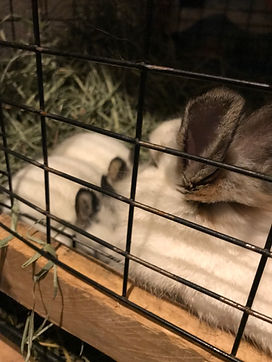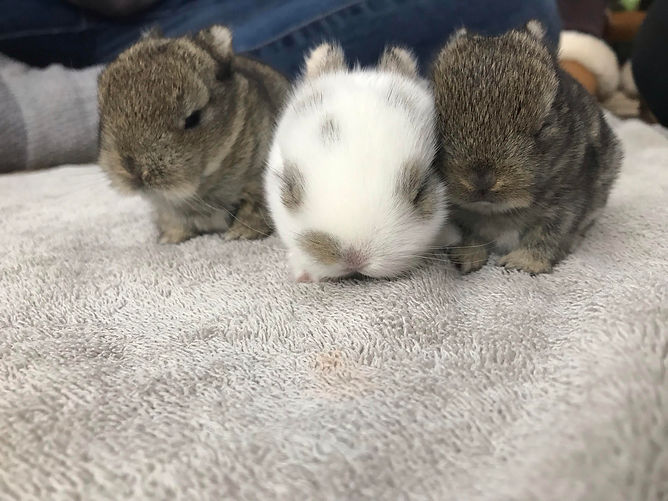
Learn About the Breed
The Netherland Dwarf averages about 2-3 lbs. The breed (as its name suggests) is from the Netherlands. They come in over 20 different colors, only a hand full are recognized by the ARBA. Life span [if properly cared for] is 7-10 years.
Basic Care
Rabbits, while not as easy to care for as say a hamster, are a fun beginner pet for kids. A mix between a dog and cat's personality, although every rabbit tends to differ in personality.
Let's get into the basics of caring for your new companion.
-
Rabbits need their nails cut at the least every two months and molt (shed) like a dog or cat. To learn more go HERE.
-
Dietary needs include; pellets, hay, water, and fresh products. To learn more go HERE.
Rabbits like routine, getting fed at the same time every day and having a nighttime routine. For me, I feed my rabbits in the morning, go hang out with them throughout the day, and every night before I go to bed they each get four Cheerios.
The Netherland Dwarf, their personality varies per rabbit. But for the best pet, socializing daily is a must. The best way to start bonding with your new rabbit is to sit down (so your rabbit isn't intimated by you) and lets your rabbit explore the area around you, and sniff you. As your rabbit starts trusting you, he/she will start putting his/her paws on you, jump onto your lap, and maybe even dig at your clothing.
-
The area in which you keep your rabbit varies per situation and person. I use wire bottom cages that are 24x24 inches. For more on housing go HERE.
-
Learn about rabbit personalities HERE.
Make sure your rabbit doesn't chew down your house
No matter what housing you choose, your probably going to let yourself run around your house at some point. So I will caution you, all wires should be picked up [your rabbit will eat/chew them], the rabbit should be in a room with all drywall and siding covered [again your rabbit will eat/chew it], make sure you don't have books or paper on the floor [it will get eaten], human food should be out of reach, and any other pets should be locked away if your rabbit isn't used to them or vice versa.
Does your rabbit need a friend?
I argue that no, your rabbit does not need a friend. Unless the rabbit you purchase is already bonded to another rabbit or I (or whatever breeder you choose) state(s) that I would like two rabbits to go to a home together. Rabbits are solitary animals in the wild, meaning they live alone. Some European wild rabbits create "colonies". An article about that, HERE.
Having two rabbits together is hard, you can't just throw two rabbits together. There is a long process of bonding them. If you are interested in bonding two (or three) rabbits there are a lot of articles online you can read. I have never done it so I am not qualified to teach about it. If you truly want bonded rabbits, I would recommend two babies of the same sex from the same litter. This way, they are already "bonded" and won't reproduce.
Should you neuter/spay your rabbit?
People neuter/spay their rabbits to prevent reproduction between different gender bond-mates. Others fix their rabbit to bring down hormonal things such as spraying or cage protectiveness. I have never fixed a rabbit, granted that's because I breed them. But I hear mixed opinions on the matter. Some people have great experiences and a good recovery. Others have terrible experiences and a bad recovery. Sometimes they die. Rabbits are delicate animals and recovery is a long road. Sometimes the stress of the surgery is what kills the rabbit. If you decided to fix your rabbit, please get an experienced vet to do the procedure. I would also recommend reading up on the recovery and other factors of the surgery. Be well informed.
What are safe toys for your rabbit?
Hay keeps down always-growing teeth but chewing on toys can also help wear down their teeth. I like to use cardboard, paper towel/ toilet paper rolls, cat toy balls (they usually have bells, which my rabbit loves the sound of. Please check that the bell is still in the ball every few days), hay balls (usually plastic balls that you can put hay in, great for rabbits who don't eat a lot of hay), baby stacking cups (take out if rabbit starts chewing on them, put them back in a few days later), pinecones (from outside), willow or apple tree branches. Usually, rabbits prefer cardboard, toilet paper rolls roll, cardboard boxes, or paper bags. I also really love all of Oxbow's rabbit toys.
Check the list for what you need when you bring your rabbit home
-
Cage (whatever option you have chosen)
-
Pellets (I use Blue Seal Bunny 16%)
-
Hay (orchard grass, timothy hay, oat hay)(buying in bulk is cheaper)
-
Water bowl (large or medium ceramic so it can't be flipped)/Water bottle (make sure it doesn't leak)
-
Food bowl (ceramic as well)
-
Hay rack
-
First Aid-Kit (to learn more go HERE)
-
A few toys
-
Litter box (if you decided to use one)
-
Litter (for wire bottoms/litter boxes, pine pellets for the tray; for plastic bottoms shredded paper or rabbit litter)
-
Plastic box for pellets
-
Large plastic box for hay
-
Nail clippers
What to do when you bring your rabbit home
No matter the age of your rabbit, they are going to be nervous when you bring them home. So upon getting home, have your rabbit's cage/area ready. Once you get the rabbit in his/her new home. Let them be for at least 24 hours before you start to hold him/her/get him/her out. If your rabbit hasn't gone to the bathroom within 12-24 hours after you brought him/her home, contact a vet. After a few days, your rabbit will get less nervous around you and will start trusting you more. Most of the time you will be given transitioatransition n feed. You mix it with your rabbit's new food and it helps them get used to the nenewsw feed.
Amazon List of Recommended Items


